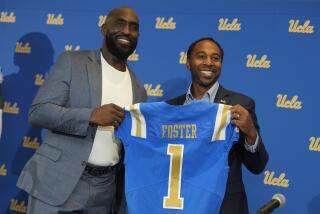Track and Field : Coghlan Finds There Are Two Sides to a Coin
- Share via
It is common for road races to offer prize money, but track and field promoters so far have not adopted the practice.
They prefer to pay appearance fees to selected athletes and then reward competitors for outstanding performances, such as world records. Because there are so many events in each meet, most promoters believe that the cost of paying athletes based on the order of finish would be prohibitive.
But long before he offered to pay $10,000 to the winner of the Pepsi Invitational’s intermediate hurdles if Edwin Moses participates May 17, promoter Al Franken was proposing the elimination of appearance fees and the establishment of purses in order to pay prize money.
There are arguments on both sides, as exemplified by a disagreement between Franken and miler Eamonn Coghlan after the Michelob Invitational last winter in San Diego.
Franken is negotiating for a reduced payment to Coghlan, who had a higher appearance fee than any other performer in the meet at $7,000. But after Coghlan finished last in the mile, Franken gave him a check for only $5,000. Franken and Coghlan’s agent, Brad Hunt, are discussing a settlement.
“When athletes set a record, they want a bonus on top of their appearance fee,” Franken said. “Why is that when they don’t perform up to expectations, they don’t offer to give money back?
“When we made an agreement with Eamonn, we were buying a 3:49 miler, the chairman of the boards, not a 4:03 miler. Eamonn has been a friend for 10 years. I don’t feel good about this. But I don’t think I owe him all of that money. I guess he doesn’t agree.”
But Franken’s proposal to pay athletes based strictly on their performances may not be entirely fair to some athletes.
After finishing fifth in the mile at the Times/GTE Indoor Games, Coghlan considered not competing two days later in San Diego. Because of a stomach ailment, he hadn’t won a race all winter.
New Zealand miler John Walker convinced Coghlan that he should go to San Diego and collect his fee because his name had been used in promoting the event, which presumably helped Franken sell tickets.
Later, in contrasting Soviet pole vaulter Sergei Bubka, who didn’t compete in San Diego because he feared aggravating an injury, and Coghlan, American miler Steve Scott said: “Bubka has an Eastern European attitude. He only thinks of himself. Eamonn has more of a free-world attitude, knowing the crowd deserves to see him even if he is off a little bit.”
So is Coghlan a hero for running with pain or a swindler for accepting money when he wasn’t physically ready to compete?
“It’s a gray area,” Franken said. “Eamonn might have been trying to help us, not wanting to embarrass us by not showing up. I’m not saying I’m totally right on this.”
Two Sides to Every Story Dept: Tom Petranoff, the American record holder in the javelin, accused one of the world’s leading javelin manufacturers, Sandvik of Sweden, of preventing him from obtaining its latest product, which is considered state of the art.
Because of the International Amateur Athletic Federation’s new rules, all companies have been forced to manufacture a less aerodynamically sound javelin than the one used in the past.
The new javelin doesn’t travel as far, which is considered by the IAAF to be safer for other athletes who are competing in the same arena as the javelin throwers. No one wants to see a high jumper impaled by a javelin.
Petranoff’s problem is that the javelin manufactured by the company he is aligned with, Pacer of Nevada, hasn’t been as effective as the one manufactured by Sandvik.
Petranoff said that Sandvik doesn’t want him to have its new javelin.
“I think they’re trying to blackball me,” he said. “That’s what I get for being the American record holder, or maybe they just hold it against me because I’ve been loyal to Pacer all these years. I can’t believe they’re doing this to me.”
Neither can Dick Tomlinson, who is Sandvik’s U.S. representative.
Tomlinson said by telephone Monday that he drove for 10 1/2 hours last weekend from his home in Live Oak, Calif., to Point Loma College in San Diego, where Petranoff trains, and left two of the new Sandvik poles in the equipment shed.
“He and I had a long talk about this last Thursday,” Tomlinson said. “He was in a panic because he wasn’t throwing as far as he feels he should. I personally delivered the javelins on Saturday morning. I don’t know what else he wants from me.”
On the bright side, Tomlinson said that Sandvik appreciates the advertising.
“If people didn’t know before that we have an edge, they know now,” he said.
More to Read
Go beyond the scoreboard
Get the latest on L.A.'s teams in the daily Sports Report newsletter.
You may occasionally receive promotional content from the Los Angeles Times.










